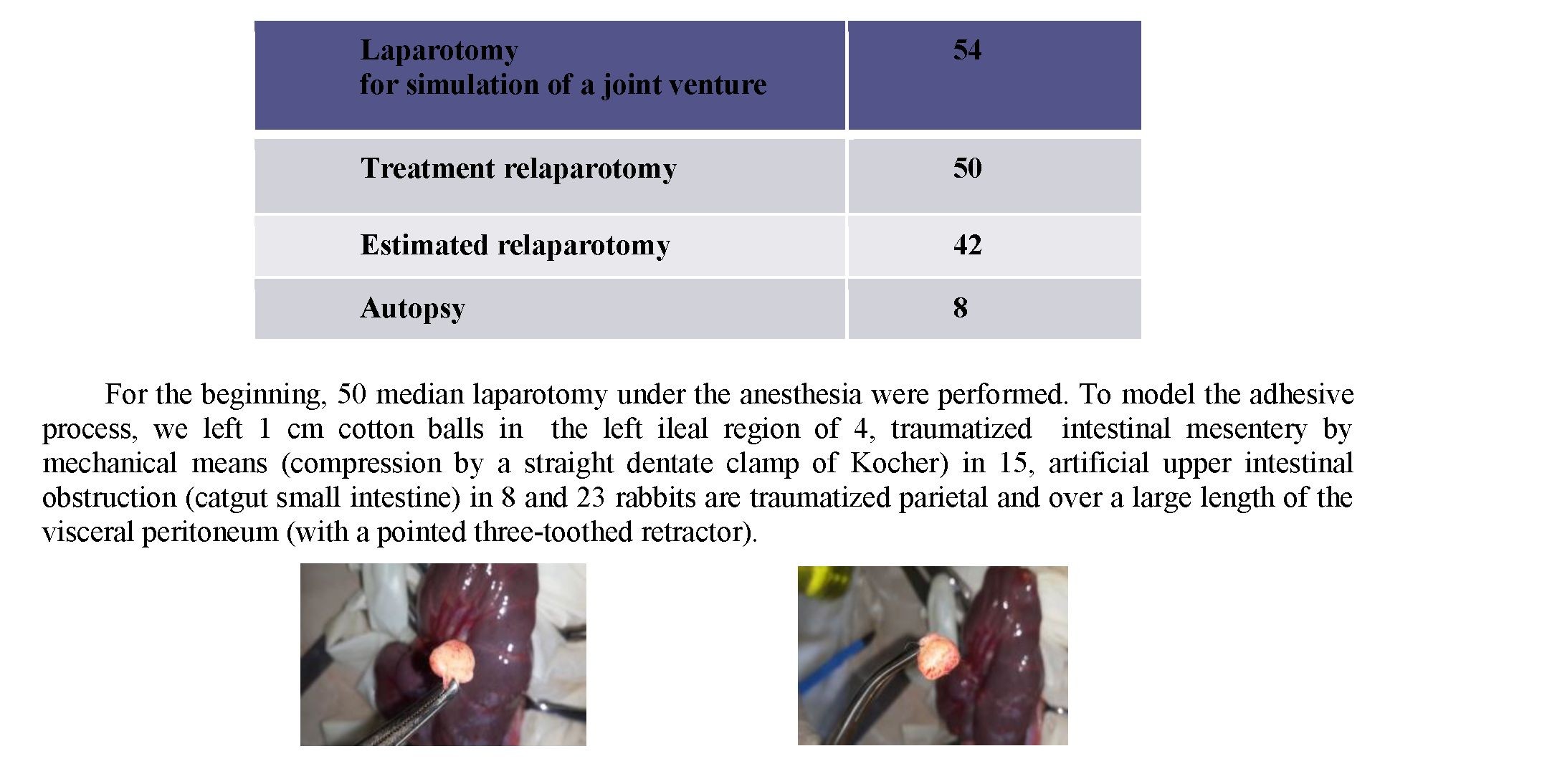Even with today's achievements of medicine and other spheres, adhesives doesn’t lose it’s relevance [1].Postoperative adhesions are the cause of abdominal pain in 30-33% of patients [2].40 to 75% of the total intestinal obstruction is associated with adhesions of the peritoneum, and the lethality with this complication remains at a high level (5-10%) and it doesn’t tend to decrease [3]. From 20 to 75% of cases of infertility in women is due to the postoperative adhesive process of the small pelvis [4].
Keywords: 3d printer, membrane, adhesive disease.

Purpose of the study: Improvement of the used and development of new methods of prevention and treatment of adhesions.Conducting laboratory and experimental studies to identify the effectiveness of the anti-poppet membrane printed by a 3D printer.
Objectives of the experiment:Definitions of the occurrence of adhesive process of the abdominal cavity among patients.Simulation of the adhesive process in the abdominal cavity in laboratory rabbits.Modeling of the adhesion process of the abdominal cavity of rabbits.Preoperative and postoperative methods for assessing the condition of laboratory animals.Carrying out of preventive maintenance and treatment of an adhesive disease of an abdominal cavity.
Scientific novelty: For the first time in-depth study, the method of preventing adhesions using the intraoperative anti-poppet membrane is printed by a 3D printer and a 3D scanner for modeling the object.
Scientific and practical significance of the work:Reduction of complications of adhesive disease of the abdominal cavity and pelvic organs.
Materials and methods of the experiment:To achieve our goal and objectives, we conducted a prospective scientific work to determine the occurrence of the joint venture. The work was based on the study of statistical data of 755 patients from different health facilities of the SKR. As a result of this work, we determined 82% of the occurrence of joint ventures from the total number of patients.After determining the relevance and the occurrence of the disease, we developed a new innovative anti-adhesive 3D membrane, which includes domestic retouched collagen and a one-time working prototype of the 3D printer itself. To create a 3D model, we developed a 3D scanner.Further, in order to determine the efficiency of 3d membranes, we performed laboratory-experimental work on rabbits from 19.08.16 to 19.02.17. Till this day, we have performed 156 laparotomies.
In 19 rabbits, after 4 days of manipulation, we abserved a worsening of the condition, hypodynamia, lethargy, refusal of food. Eight rabbits were vomiting, stitch the abdomen. In the beginning, increased peristalsis. After 12 hours, there is no peristalsis. All rabbits had hyperthermia 39.6-40.6 '
After achieving the modeling of the adhesive process, 50 relaparotomies were performed. In rabbits suffering from diffuse serous peritonitis, we did resection and ligation of the necrotic area of the mesentery of the intestine, revision and sanitation of the abdominal cavity, the creation of the 3D model, and the coating with membrane operated mesentery were performed.
In rabbits suffering from OINP, we did relaparotomy, resection of the necrotic intestinal area, end-to- end anastomosis, sanitation and revision of the abdominal cavity organs, creation 3d model and coating with membrane operated site (for anastomosis) were performed.
1 5
Conclusions: Adhesive disease occurs in 82% of patients. Using 3D membrane reduces the amount of adhesion and conducts good prophylaxis. It is necessary to use membrane on all surfaces of the operative field. The ability to control the amount, concentration and size of the membrane by collecting parameters of each patient makes it possible to improve effect of treatment and prevention of AD. Using domestic means to print the membrane significantly reduces the price. But most importantly, it gives a start to the development of domestic innovative medicine and the possibility of predominance in the development of prevention and treatment of AD.
Reference
- 1. Ivanov PA, 2004; Petrov VP, 2009.
- Mathias D., et al., 2011
- DvoynikovS.Yu., 2003; Adamyan L.V. et al., 2007; Menzies D., 2008; Vrijland W.W., et al., 2012.
- Greenblatt E.P., et al., 2014.
- Yarema IV, 2009; Diamond M.P., 2009.
- Vivisection FAQ, British Union for the Abolition of Vivisection; "The Ethics of research involving animals", Nuffield Council on Bioethics - 2005 - section 1.6.
- Bolshakov OP, Neznanov NG, Babakhanyan RV Didactic and ethical aspects of research on biomodels and laboratory animals. Qualitative clinical practice 1/2002
- Singer P. Chapter 2: Tools for Research ... Your Taxes at Work. In Animal Liberation. Singer P. New York, NY: Harper Collins-2002 - pp. 25-94
- Philpott S. Audio-Enabled Powerpoint Lecture: The Use of Animals in Research. UGS Bioethics Program, USA, NY - 2011.
- Tishenko P.D. Ethical problems of biotechnology development. Bioethics and humanitarian expertise. Вып.2.М .: IFRAN - 2008.
- Bernard E. Rollin. The Regulation of Animal Ethics: A Conceptual History, In Theoretical Medicine and Bioethics, Volume 27, Number 4 - 2006 - pp. 285-304.